





Sansevieria, or the Mother-in-Law's Tongue / Snake Plant as it's commonly known is a truly remarkable and striking easy care house plant. 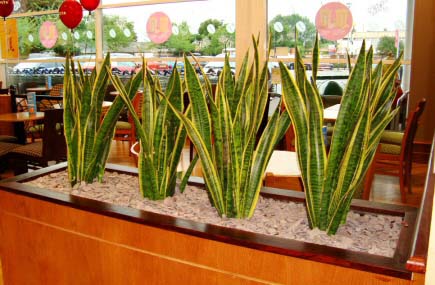 It belongs to the family Asparagaceae, native to the tropics of West Africa. It's an ever increasingly popular indoor plant and much of this has to do with its near indestructible qualities. However the Snake Plant is also desired for its upright and erect leaf habit which fits in to almost all locations in the home from both traditional to modern day settings. It's bold and clutter free lines make it a very popular and one of the plants of choice for architecture and interior design,.
It belongs to the family Asparagaceae, native to the tropics of West Africa. It's an ever increasingly popular indoor plant and much of this has to do with its near indestructible qualities. However the Snake Plant is also desired for its upright and erect leaf habit which fits in to almost all locations in the home from both traditional to modern day settings. It's bold and clutter free lines make it a very popular and one of the plants of choice for architecture and interior design,.
A lot of people believe the name comes from "Sand Snake", with its cacti like properties and appearance of a rising snake it's not hard to see why. However the plant genus was actually named in 1794 by the Swedish naturalist Carl Thunberg after Raimondo di Sangro (1710-1771), Prince of San Seviero. There are a huge number of different Sansevieria's out there which you may be able to get your hands on (and if you get the chance you really should), however there are only really four you will find easily:
S. trifasciata laurentii (Mother-in-Law's Tongue)
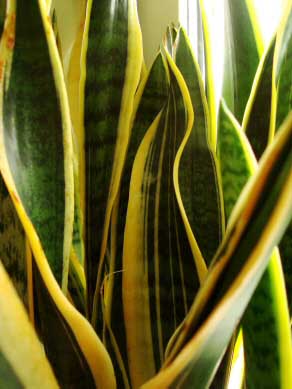 This is the most famous and easily recognised, traditionally it was used as a striking background for smaller plants with flowers or ferny foliage. The modern trend in the average home is to keep the plant separate from others and have it standing bold and alone. On occasion in larger areas it is used in mass to create a fence like effect, this is often seen in public places like restaurants, malls/shopping arcades and coffee shops although larger homes might also adopt elements of this style. Laurentii literally means "three bundles" and this can be seen in the leaf markings of the variety. Each leaf is edged on both sides with solid lines of vertical yellow, in the center there are two different shades of horizontal zig zag green stripes.
This is the most famous and easily recognised, traditionally it was used as a striking background for smaller plants with flowers or ferny foliage. The modern trend in the average home is to keep the plant separate from others and have it standing bold and alone. On occasion in larger areas it is used in mass to create a fence like effect, this is often seen in public places like restaurants, malls/shopping arcades and coffee shops although larger homes might also adopt elements of this style. Laurentii literally means "three bundles" and this can be seen in the leaf markings of the variety. Each leaf is edged on both sides with solid lines of vertical yellow, in the center there are two different shades of horizontal zig zag green stripes.
S. trifasciata (Snakeskin Plant)
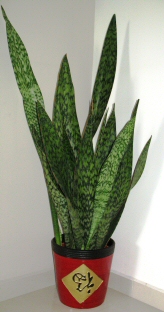 This variety is actually the same as S. laurentii without the laurentii! This means you are left with a plant without any of the yellow edges. This arguably makes it less desirable and of interest to look at, however it still has the upright and hardy attitude of its cousin and the attractive horizontal green stripes. While all Sansevieria are accommodating with wherever you put it, the S. laurentii yellow will fade some what if you put it in heavy darkness. As S. trifasciata has no yellow edges to lose it is therefore even more tolerant of shady conditions . If you take leaf cuttings of S. laurentii it will almost always revert to this all green S. trifasciata, i.e. the yellow edges are completely lost.
This variety is actually the same as S. laurentii without the laurentii! This means you are left with a plant without any of the yellow edges. This arguably makes it less desirable and of interest to look at, however it still has the upright and hardy attitude of its cousin and the attractive horizontal green stripes. While all Sansevieria are accommodating with wherever you put it, the S. laurentii yellow will fade some what if you put it in heavy darkness. As S. trifasciata has no yellow edges to lose it is therefore even more tolerant of shady conditions . If you take leaf cuttings of S. laurentii it will almost always revert to this all green S. trifasciata, i.e. the yellow edges are completely lost.
S. cylindrica (Spear Sansevieria)
Again S. cylindrica has very upright and strong green leaves, although newer growth will bend strongly towards light if in quite a dark location, this means you may end up with more of a wider rather than tall plant overall. The leaves, as you may be able to guess by it's name, are cylindrical in shape and are incredibly tough. 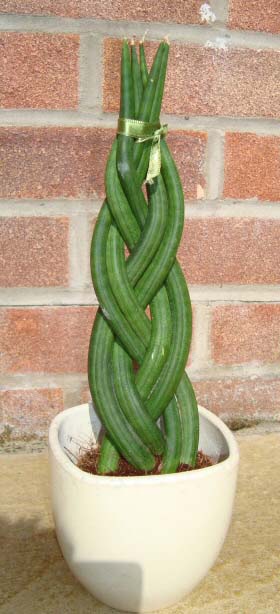 It's not possible to bend the leaves when they have matured without snapping them. The unusual style alone is enough for some people, but its natural inclination to bend towards light when the new flexible growth forms is exploited by nurseries, the picture on the left shows you how. As the plant has grown, the leaves have been plaited together. Six of the fleshy leaves have been used to create this plait, you can also find more complex and larger designs although they will obviously cost more.
It's not possible to bend the leaves when they have matured without snapping them. The unusual style alone is enough for some people, but its natural inclination to bend towards light when the new flexible growth forms is exploited by nurseries, the picture on the left shows you how. As the plant has grown, the leaves have been plaited together. Six of the fleshy leaves have been used to create this plait, you can also find more complex and larger designs although they will obviously cost more.
Some people argue this trick is a fad. In practice they might be right, but it's a very unique fad you have to agree. The draw back is that just before they are shipped from the nursery to the shop for you to buy, the top tips are "knocked" or picked off. The majority of plants have a hormone that is produced in the top of the main stem, this hormone encourages upward growth through that particular leaf. When the top has been removed no more hormone and therefore no more upward growing, this results in growth from the side shoots lower down the plant. S. cylindrica has no side shoots so it starts producing new leaves directly from the soil. So eventually your beautifully sculptured plait will look out of place surrounded by untrained natural growth. On the plus side, like all Sansevieria, S. cylindrica is slow growing so you will have your architectural design for quite a time.
S. hahnii (Golden Bird's Nest)
After 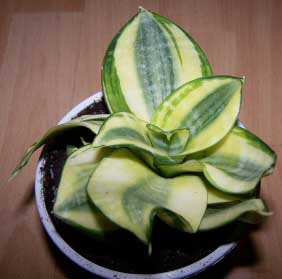 all the attention grabbing and elegance of the previous three Sansevieria varieties, S. hahnii is quite vanilla. Whilst like its cousins in the hardy and interesting to look at stakes, it has less curb appeal. The reason for this is ultimately because it doesn't grow very high or wide, it's brilliant however if you don't have a great deal of space but enjoy the cacti like appearance with the unusual variegation found on S. laurentii. They would be especially useful for a windowsill.
all the attention grabbing and elegance of the previous three Sansevieria varieties, S. hahnii is quite vanilla. Whilst like its cousins in the hardy and interesting to look at stakes, it has less curb appeal. The reason for this is ultimately because it doesn't grow very high or wide, it's brilliant however if you don't have a great deal of space but enjoy the cacti like appearance with the unusual variegation found on S. laurentii. They would be especially useful for a windowsill.
Light
The Snake Plant likes bright light with at least some direct sun for several hours a day, however it will still grow in any position (although a little bit slower) as long as it's not deep shade.
Watering
Water moderately from Spring to Autumn/Fall, significantly less in the Winter months because it does not need as much water then and you will reduce the possibility of your Snake Plant rotting from being over watered.
Humidity
Unimportant for all varieties of Sansevieria
Feeding
When it comes to feeding a standard cactus or all purpose fertiliser during the Summer months is perfect. Careful not to over do it though.
Temperature
Tough though Sansevieria is, it will suffer with very cold Winter temperatures. If the soil is dry it will survive without issue down to 5°C / 41°F. Good average growing conditions will need temperatures between 18°C - 27°C / 65°F - 80°F.
Repotting
If you want flowers on your Snake Plant (see below) it will need to be pot bound. In any case due to their upright growth habit the plants look best in a smaller narrow pot. If you do decide to repot then you can do it at anytime of the year.
Propagation
You can propagate S. laurentii, S. trifasciata, S. cylindrica and S. hahnii when you repot by removing the rhizome offsets at the base of the plant. 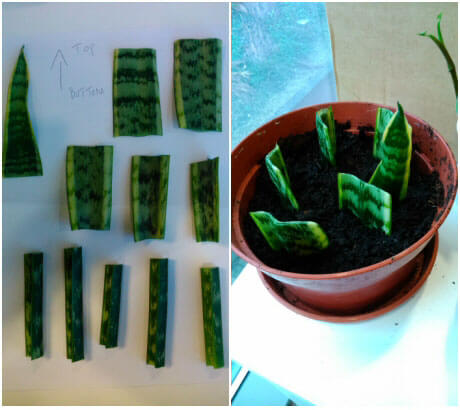 Let them dry for a few days before pushing into a good drainage potting compost mix. You may also have luck with leaf cuttings; cut 2 - 3 inch of leaf from a mature leaf and after waiting a day for the edges to dry, push the cuttings about 1 inch into a compost mix (you must plant it the right way up i.e. matching the direction of original growth).
Let them dry for a few days before pushing into a good drainage potting compost mix. You may also have luck with leaf cuttings; cut 2 - 3 inch of leaf from a mature leaf and after waiting a day for the edges to dry, push the cuttings about 1 inch into a compost mix (you must plant it the right way up i.e. matching the direction of original growth).
Be warned that If you try and propagate S. laurentii in this way you will almost certainly lose the yellow edges as it will revert back to the original all green S. trifasciata variety.
Speed of Growth
The Snake Plant does grow slowly which can be a draw back if you want a large one to screen an area immediately. If that's the case, go large at purchase time.
Height / Spread
S. cylindrica, although rare, has the potential to reach 5ft after many years. S. hahnii in comparison will only reach a lowly 4 in. high. S. laurentii and S. trifasciata can get to 3ft or more, although this is quite unusual and normal expected height is between 1ft and 2ft. However if you want a more compact and wide spread plant rather than height, simply remove the very tops of the growing leaf when its reached your ideal height. Bear in mind if you do this that particular leaf will never grow taller.
Flowers
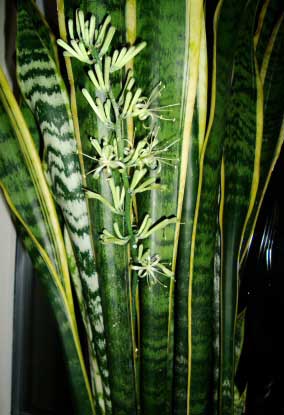 Yes! They appear on S. trifasciata and S. laurentii in Summer on very fast growing stems from the heart of the plant. They are attempting to attract moths for pollination, so during the evening and night they smell strongly of something similar to Ylang Ylang. During daylight hours the smell is musky and not very pleasant, you may also notice sticky resin dropping onto or around the plant (There is a close up picture of the resin in the gallery above).
Yes! They appear on S. trifasciata and S. laurentii in Summer on very fast growing stems from the heart of the plant. They are attempting to attract moths for pollination, so during the evening and night they smell strongly of something similar to Ylang Ylang. During daylight hours the smell is musky and not very pleasant, you may also notice sticky resin dropping onto or around the plant (There is a close up picture of the resin in the gallery above).
However, if you want to try getting them it can be tricky, in our experience you only get Sansevieria flowers when you are "cruel". The plant needs to be so pot bound that there is literally no space for new shoots to emerge out of the soil (this may happen naturally in the center of a congested plant which isn't fully pot bound yet). You also need to nick the top off some of the leaves which prevents it growing upwards. With absolutely no where left to grow you might get the plant trying to propagate itself by seed, i.e. through the elusive flowers.
Anything else?
A fantastic hardy plant that will cope with masses of different conditions and treatment, however if you want it to perform at its best you do need to treat it right.
Copyright © www.100flowers.win Botanic Garden All Rights Reserved